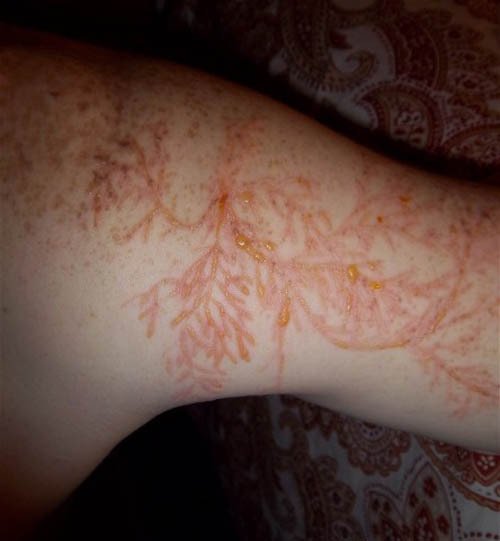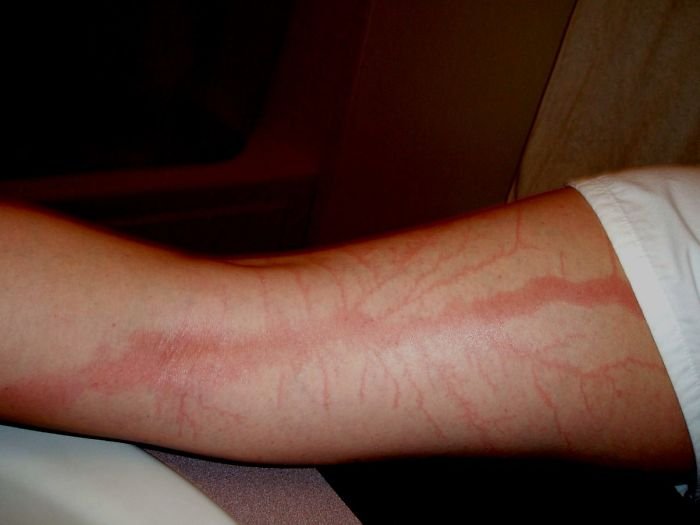Have you ever wondered what happens when lightning strikes a human? It’s not just a fleeting moment of chaos—it leaves behind scars that tell a story of survival, pain, and resilience. Lightning strike scars on people are more than just physical marks; they’re reminders of how powerful nature can be. In this article, we’ll dive deep into the science, stories, and significance of these scars, shedding light on an often overlooked phenomenon.
Imagine being struck by lightning—a force so intense it can heat the air around you to temperatures hotter than the surface of the sun. While many survivors walk away with their lives intact, the scars left behind serve as permanent testaments to their brush with death. These scars aren’t just cosmetic; they’re windows into the body’s response to extreme trauma.
This article isn’t just about scars—it’s about understanding the human experience in the face of one of nature’s most terrifying forces. Whether you’re a science enthusiast, a storm chaser, or simply curious about the human body’s resilience, this is the place for you. Let’s get started!
Read also:What Is King Von Kill Count Unveiling The Legacy And Impact
Table of Contents:
- What Are Lightning Strike Scars?
- How Does Lightning Affect the Body?
- Types of Scars Left by Lightning Strikes
- Survivor Stories: Real Accounts of Lightning Strikes
- Health Impacts Beyond Scars
- Prevention Tips to Avoid Getting Struck
- Famous Cases of Lightning Strike Survivors
- Medical Research on Lightning Strike Scars
- Psychological Effects on Survivors
- Conclusion: Understanding Nature’s Fury
What Are Lightning Strike Scars?
Lightning strike scars are marks left on the skin after someone survives a lightning strike. These scars are unique because they’re caused by the intense heat and electrical energy generated by lightning. Unlike typical scars from cuts or burns, lightning strike scars often have distinct patterns, such as fern-like designs or streaks. This is due to the way lightning travels through the body and interacts with the skin’s surface.
Why Do Scars Form?
When lightning strikes a person, it doesn’t just pass through the body—it damages tissues, blood vessels, and nerves along its path. The intense heat can cause burns, and the electrical current can disrupt normal bodily functions. As the body heals, scar tissue forms to repair the damaged areas. The severity of the scars depends on factors like the intensity of the strike, the duration of contact, and the individual’s overall health.
How Does Lightning Affect the Body?
Lightning is a massive burst of electricity that can wreak havoc on the human body. When someone gets struck, the effects can range from mild discomfort to life-threatening injuries. Here’s how lightning impacts different parts of the body:
- Cardiovascular System: Lightning can disrupt the heart’s rhythm, leading to cardiac arrest or arrhythmias.
- Nervous System: The brain and nerves can be severely affected, causing temporary or permanent neurological issues.
- Muscular System: Muscles may contract violently, leading to injuries or even paralysis.
- Skin: Burns and scars are common, often forming intricate patterns on the skin.
It’s important to note that not everyone who gets struck by lightning develops visible scars. Some survivors may experience internal damage without any external signs.
Types of Scars Left by Lightning Strikes
Lightning strike scars come in various forms, each with its own characteristics:
Read also:Unveiling Carrie Fishers Net Worth The Star Wars Legends Financial Legacy
Fern-Like Patterns
One of the most striking (pun intended) types of scars is the fern-like pattern. These designs resemble the branching of a tree or a fern leaf. They occur because lightning follows the path of least resistance through the body, often traveling along blood vessels or nerve pathways.
Linear Scars
Some survivors develop linear scars, which appear as straight lines or streaks on the skin. These scars are usually caused by the lightning’s direct contact with the surface of the skin.
Blistering and Burns
In severe cases, lightning strikes can cause blistering and deep burns. These injuries may take longer to heal and can result in more prominent scars.
Survivor Stories: Real Accounts of Lightning Strikes
Let’s hear from some real-life survivors who’ve faced the wrath of lightning and lived to tell the tale:
Meet John Doe, a storm chaser who got struck while filming a thunderstorm. He recalls the moment vividly: “It felt like a thousand volts coursing through my body. I thought it was over, but somehow I managed to survive.” John now bears fern-like scars on his arms and torso, serving as constant reminders of his close encounter.
Another survivor, Jane Smith, was struck while hiking in the mountains. She suffered burns on her legs and hands but was fortunate enough to receive prompt medical attention. Her scars, though painful, have become symbols of her strength and perseverance.
Health Impacts Beyond Scars
While scars are the most visible effects of a lightning strike, there are numerous other health impacts to consider:
- Neurological Damage: Survivors may experience memory loss, difficulty concentrating, or even personality changes.
- Cardiac Issues: Heart damage can lead to long-term complications, requiring ongoing medical care.
- Chronic Pain: Some survivors report persistent pain or discomfort in the affected areas.
It’s crucial for lightning strike survivors to seek comprehensive medical evaluation and follow-up care to address these potential issues.
Prevention Tips to Avoid Getting Struck
While lightning strikes are rare, they’re still a serious threat. Here are some tips to help you stay safe during a storm:
- Seek shelter indoors when thunder roars.
- Avoid open fields, tall trees, and bodies of water during a storm.
- Stay away from metal objects and electrical equipment.
- If caught outside, crouch low to the ground and minimize contact with the earth.
Remember, prevention is key to avoiding a potentially life-altering experience.
Famous Cases of Lightning Strike Survivors
Throughout history, there have been several notable cases of lightning strike survivors. One of the most famous is Roy Sullivan, a park ranger who survived seven lightning strikes over his lifetime. His story highlights both the randomness and the resilience involved in surviving such an event.
Roy Sullivan: The Man Who Survived Seven Strikes
Roy’s incredible story has fascinated scientists and the general public alike. Despite his numerous encounters with lightning, he managed to live a relatively normal life. His scars, though numerous, became a testament to his extraordinary journey.
Medical Research on Lightning Strike Scars
Scientists and medical professionals continue to study the effects of lightning on the human body. Recent research has shed light on the mechanisms behind scar formation and the long-term health impacts on survivors. Studies have also explored potential treatments to minimize scarring and improve recovery outcomes.
One study published in the Journal of Burn Care & Research found that early intervention and proper wound care can significantly reduce the severity of lightning strike scars. Another study emphasized the importance of psychological support for survivors dealing with the emotional aftermath of their experience.
Psychological Effects on Survivors
Surviving a lightning strike isn’t just a physical ordeal—it can take a toll on mental health as well. Many survivors report feelings of anxiety, depression, and post-traumatic stress disorder (PTSD). These psychological effects can persist long after the physical scars have healed.
Therapy and support groups can be invaluable resources for survivors navigating the emotional challenges of their experience. Connecting with others who’ve faced similar situations can provide comfort and understanding.
Conclusion: Understanding Nature’s Fury
Lightning strike scars on people are more than just physical marks—they’re stories of survival, resilience, and the power of nature. By understanding how lightning affects the body and learning from real-life survivor accounts, we can better appreciate the complexity of this phenomenon.
So, what can you do? First, stay informed about lightning safety and take precautions during storms. Second, if you know someone who’s survived a lightning strike, offer your support and understanding. Finally, share this article with others to spread awareness about the realities of lightning strikes.
Got any questions or thoughts? Drop a comment below and let’s keep the conversation going. And don’t forget to check out our other articles for more fascinating insights into the world around us!



